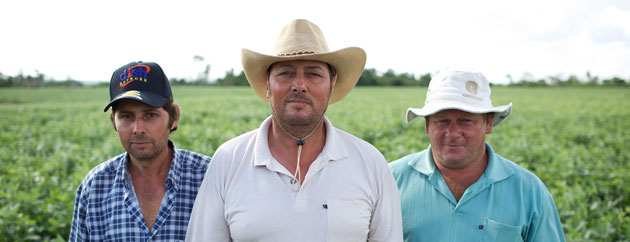
Raising Resistance
03 April, 2012How do we meet the ever increasing demand for food, without harming small farmers and relying on genetically modified monocultures? That is the premise of director Bettina Borgfeld’s 2011 documentary Raising Resistance screened last week as part of the Human Rights Watch Film Festival. Though she never resolves such a complex issue, or even suggests any viable alternatives, Borgfeld focuses on a Paraguayan tale of displacement and tension that no doubt speaks to the world over.
Our story is that of small-scale farmer Geronimo Arevelos and his community battling against Brazilian mid-scale soy farmers. Panoramas of their surroundings worthy of the Hudson River School are often mixed with participatory, on-the-ground sequences capturing heated debate; this is a documentary that aims to portray the true lie of the land. The presence of the Brazilian ‘foreigners’ is as conspicuous as their thickly-accented Spanish. They represent the corporate interest in monoculture farming, part of a worldwide attempt to cultivate ‘green gold’ and cash in on our growing levels of consumption.
Variety of perspective is where the film succeeds. Rather than demonising the Brazilians who have been funded by corporations, we are also presented with one family caught in the crossfire between the campesinos – the original owners of the land – and financial reliance on their suppliers. The farmer watches on as the campesinos occupy the land where crops are sprayed with a lethal concoction of herbicides and other toxic chemicals. The community resents how their own land is sucked dry of nutrients, that their subsistence crops are killed and how their environment is contaminated. All actors are controlled by an omnipotent force that never quite unearths itself from underneath the soya.
Informative it is, without running the risk of boring an audience with so many sources to consider. The numerous tete-a-tete interviews are never overtly emotive, and show actual intimacy suggesting that the makers of this documentary have done so with the support of everyone involved. However, and in an attempt to string all the characters and events involved, the documentary is driven by a central narrative that maps the rallying of the community, their protest and their eventual subjugation. Although appreciated, this attempt to provide a coherent narrative is also where the film falls short. At the crucial moment of rebellion the story is stemmed. Following the President Lugo Mendez’s ruling that such complaints must go through the correct governmental channels, all the previously indignant campesinos are seen dismantling their tarpaulin tents, without a flinch of dissent.
The reason why this change appears so abrupt is because of a general lack of detail. This extra information would appear indispensible to gain a real understanding of their situation. Never explained to us is how the community was originally displaced, not their entitlement to the land. No insight is given as to their relationship with local government and so their final, voluntary displacement does little to favour their cause. Borgfeld has attempted to include so many facets – the resistant Magosa weed, asset management spokesmen, campesinos migrating to the city – that some of the central tragedy is forsaken. Though this mirrors the magnitude of the monoculture industry, some fundamentals have been neglected. This is not to take away from the monumental success of the documentary, but when we see the eponymous resistance is in decline – rather than being raised – we cannot ignore some of the basic questions that should have been answered, so as to fully sympathise and support the campesinos.
Follow Sounds and Colours: Facebook / Twitter / Instagram / Mixcloud / Soundcloud / Bandcamp
Subscribe to the Sounds and Colours Newsletter for regular updates, news and competitions bringing the best of Latin American culture direct to your Inbox.

